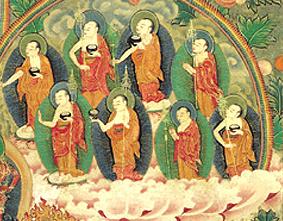Sravakayana
Sravakayana (Skt. śrāvakayāna; T. nyan thos kyi theg pa; C. shengwen sheng; J. shōmonjō; K. sŏngmun sŭng 聲聞乘) is translated as "vehicle of disciples" or "vehicle of listeners".
Within the Mahayana classification of the path, the Sravakayana is identified as the first of the three vehicles; the other two being the pratyekabuddhayana and the bodhisattvayana.
The śrāvakas are said to be motivated by a feeling of renunciation, the wish to escape from all the realms of samsara by themselves alone.
The result of the Sravakayana path is the level of Arhat—an individual who achieves liberation as a result of listening to the teachings (or lineage) of a fully-awakened buddha (samyaksambuddha).
Within the three yanas
In the Abhidharma-samuccaya, Asaṅga describes the types of person who follow each the three yanas (vehicles) as follows:
- Those who follow the Śrāvaka Vehicle (Skt. śrāvakayanika) are described as having weak faculties, following the Śrāvaka Dharma, utilizing the Śrāvaka Piṭaka, being set on their own liberation, and cultivating detachment in order to attain liberation.[1]
- Those in the Pratyekabuddha Vehicle (Skt. pratyekabuddhayānika) are portrayed as also utilizing the Śrāvaka Piṭaka; they are said to have medium faculties, to follow the Pratyekabuddha Dharma, and to be set on their own personal enlightenment.[1]
- Finally, those in the Mahāyāna (Skt. mahāyānika) are portrayed as utilizing the Bodhisattva Piṭaka, as having sharp faculties, following the Bodhisattva Dharma, and set on the perfection and liberation of all beings, and the attainment of complete enlightenment.[1]
See also
Notes
Sources
 Shravaka yana, Rigpa Shedra Wiki
Shravaka yana, Rigpa Shedra Wiki- Robert E. Buswell Jr., Donald S. Lopez Jr., The Princeton Dictionary of Buddhism (Princeton: 2014), s.v. śrāvakayāna
| This article includes content from Śrāvakayāna on Wikipedia (view authors). License under CC BY-SA 3.0. |
